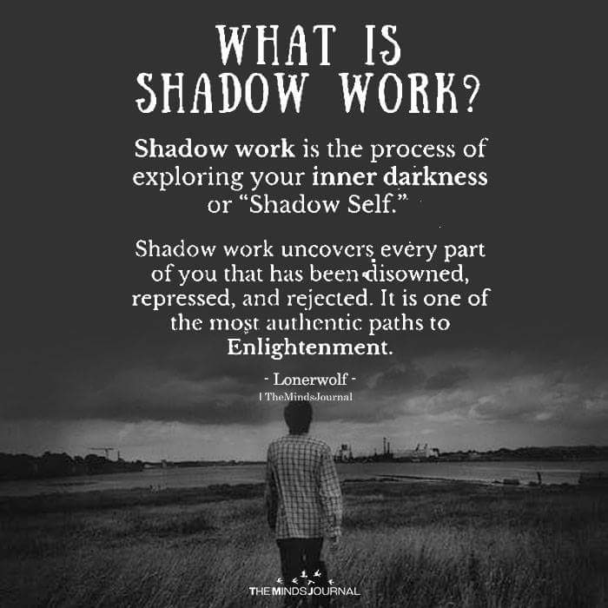We tend to use thousands of metaphors to refer to our darker side, how to discover our demons, our shadow, our alter ego, etc. , but I like to call it the big bag we all drag.
An invisible bag that accompanies us throughout our lives, in which we began to throw, from very young, all those facets of our personality that upset those around us and that exerted a kind of influence on our lives, in order to remain worthy of your love.
- “Each of us casts a darker.
- More compact shadow when it is less embodied in our conscious lives.
- This shadow is.
- In all effects.
- An unconscious obstacle that inhibits our best intentions.
- (Carl Gustav Jung).
The shadow of each of us develops during childhood naturally, like our ego, from the same life experience.
On the one hand, we identify with certain ideal features of our personality such as goodness or good manners, and on the other hand, we unearth qualities that do not correspond to our ideal image, such as selfishness or envy, frustrations or painful experiences. , hiding them in the back of our bag.
Each culture, and even each family, determines in its own way what corresponds to the ego and what corresponds to the shadow, in relation to the members of its system, some will allow the expression of anger, aggression, sexuality or intense emotions, while others will suppress them.
In this way our bag grows, as does that of our family, culture or society. Have we filled this imaginary bag for the first twenty years of our lives and, the rest of the time, tried to empty it?
And the fuller it is, the more things inside, the less energy we will have in our daily lives, and the more energy will be inaccessible inside.
What happens is that on any other day, or when we decide to open it, everything we put in our bag will appear as a great shadow and with great hostility; when we refuse to accept some of our personality, it becomes hostile, as if it had organized a mutiny against ourselves.
What we don’t face ends up surprising us unpleasantly at some point
Thus, we can understand shadow as those qualities that we do not accept in ourselves, those that, when we look in the mirror, are not visible in our reflection, because we only see what we want to see. And the encounter with her, involves a confrontation with himself.
And even if the feelings and abilities exiled in the shadows feed the hidden power of the dark side of human nature, not all are negative. Shadow is not only the focus of emotional bonds, childhood parts, or neurotic symptoms, but also skills and talents. that the person has not developed.
In this way, our personal shadow contains potential skills and qualities that have never manifested; it is a part of the unconscious that completes our ego, and represents the parts of our conscious personality that we do not want to know, that we forget or bury deep in our mind, only to find them later in the clashes we will do. have with others.
But we cannot perceive the shadow directly, because it escapes the light of consciousness and is visible only outside of us, through others, through its jerks and actions.
We can see it if we are aware that when we disproportionately admire or reject a quality of a person, such as laziness or sensuality, we probably project ourselves on it, with the intention of getting rid of that characteristic in our shadow.
Therefore, to discover certain characteristics of our shadow, we must examine what traits or attitudes disproportionately annoy or please us and to what extent they affect us.
Recovering our shadow then involves facing it and integrating its content into a more global and complete image of ourselves, leaving aside our rigidities and fears, a process that usually occurs when we see our life stagnant and when we lose interest in it and its meaning.
Working with our shadow is the voluntary and conscious process, in which we immerse ourselves with the intention of assuming everything that we had decided to ignore or repress, this will allow us to remedy our relational problems, by bringing light to darkness and penetrating. our own self, integrating it.
When we accept our cruellest aspects, we explore our most positive aspects.
Reconciling with our demons or enemies does not eliminate them, but it changes the relationship we have with them, which is much more human, we can do it through therapy or even through art.
When our strength discovers its own vulnerability and we realize that in addition to light we are also made of shadows, when we cease to believe that the responsibility of all evil is outside of us, when we are aware that the capacity for evil is also emerging. Something like, inside, we can make peace with our shadow and sail safely from adversity and destiny.
Because when we maintain a proper relationship with the shadow, the unconscious is no longer dangerous. Jung once said, “Shadow is only dangerous when we don’t pay the attention it needs. “
Bibliography used: Connie Zweig. (1991). He knows the shadow. The power of the hidden side of human nature. Barcelona: Editorial of Kairs.

